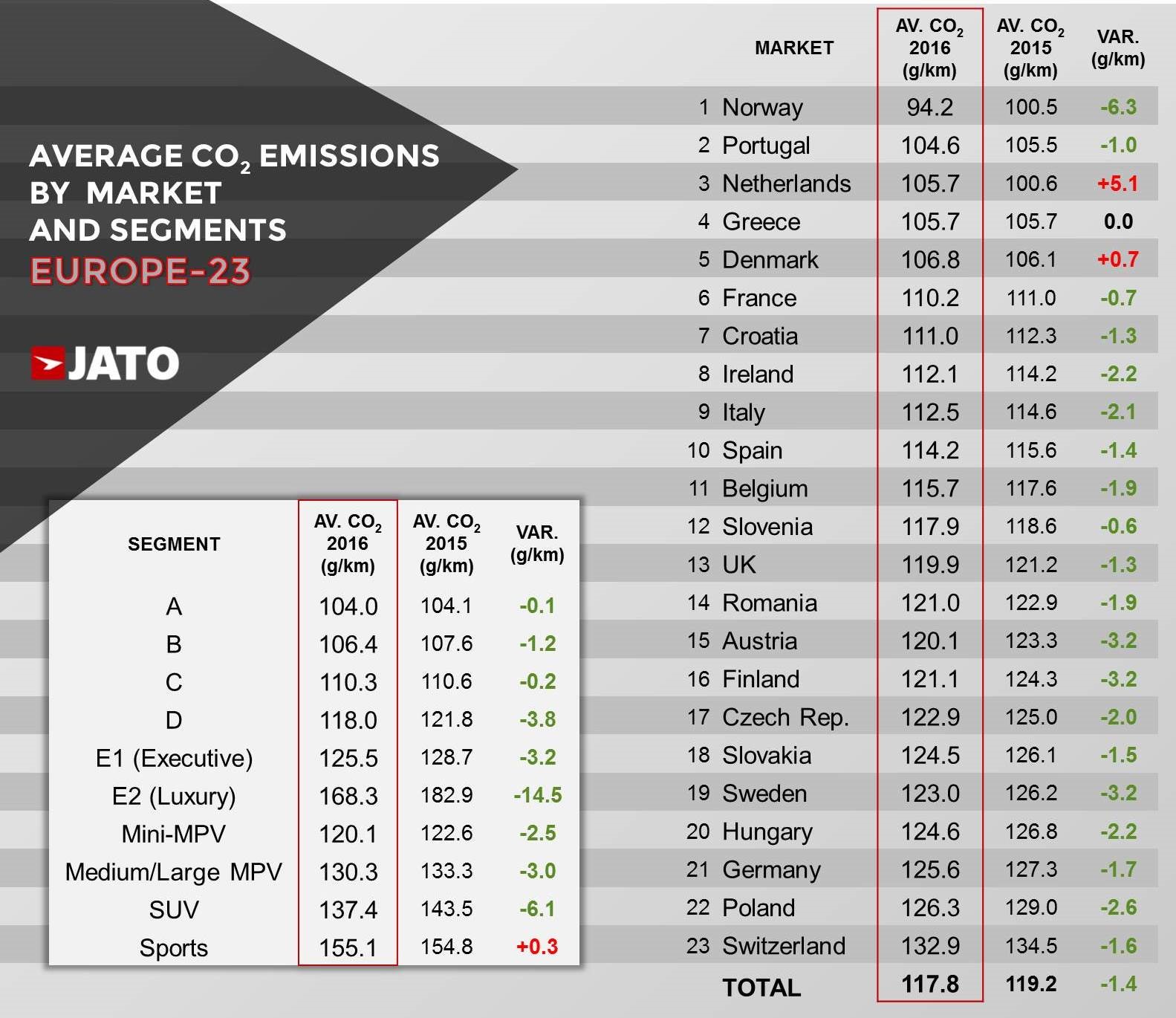Peugeot the leading brand for average CO2 emissions, as European total average fell in 2016
- New car average CO2 emissions decreased by 1.2% in 2016, with Norway responsible for the largest decrease in CO2 levels
- Peugeot led the brand ranking, with its average emissions falling by 1.7g/km in 2016
- The data is being released as the industry prepares for the implementation of WLTP, which is expected to dramatically impact CO2 emissions monitoring
Average CO2 emissions for new cars in Europe fell during 2016 demonstrating the continued progress being made by the industry. The analysis carried out by JATO Dynamics covered 23 European markets and showed that average CO2 emissions fell by 1.2% in 2016 – finishing at 117.8 g/km. The result was 1.4 g/km lower than the total seen in 2015, but this represents the smallest annual percentage improvement for the last ten years. In part this can be attributed to the slower growth of diesel registrations in 2016, which produce lower CO2 emissions.
On a country level, Norway had the lowest CO2 emissions of all countries analysed. Incentives to increase the use of EVs and hybrids resulted in these segments accounting for 39% of the country’s total registrations. Notably, the Netherlands and Denmark were the only two markets with increased average CO2 emissions in 2016, again the major driver of change was government policy – the reduction of tax incentives in the Netherlands resulted in a 53% fall in demand for PHEVs, and increased tax rates for EVs in Denmark resulted in a 71% fall in EV registrations.
Peugeot led the brand ranking for a second year – it decreased its CO2 emissions by 1.7g/km. This was primarily due to a lower CO2 emission average for its petrol engines. Peugeot’s top-seller, the Peugeot 208, decreased its average CO2 emissions by 1.3g/km from 99.3g/km to 98g/km. PSA Group’s other volume brand Citroën, occupied second place with 103.3g/km, which is a reduction of 2.3g/km compared to 2015. Both Peugeot and Citroën benefit from their smaller ranges of SUVs / large vehicles. Overtaking Renault in third place was Toyota, whose improvements were largely thanks to the strong performance of its hybrid range, which accounted for 39% of its European registrations in 2016. Notably, Toyota’s average emissions for its hybrid range grew by 4.3g/km due to the launch of its RAV4 Hybrid.
The only brands not to decrease CO2 emissions in 2016 were Nissan, Ford and Mazda, this can largely be attributed to the prominence of these brands with regards to particular models. A significant portion of Nissan’s registrations were SUVs; the Nissan X-Trail posted an average emission of 138.1g/km and was the brand’s third best-selling model. Similarly, Ford and Mazda’s average CO2 emissions increases can be attributed to increased registrations of the Mustang and MX-5 respectively.
The SUV boom dominated the automotive world in 2016, and the success of newer compact SUV models – such as the Tiguan and Tucson – helped to decrease the segment’s CO2 emissions by 6.1 g/km. The luxury cars decreased their average by 14.5 g/km, due to lowered emissions across the segment and increased diesel and PHEV registrations. The Sports segment was the only category to increase CO2 emissions. This was due to the high volume of registrations of the Ford Mustang V8 which negated the improvements made by the BMW 4-Series, Mercedes Class Coupé, MINI Convertible and Porsche 911.
“It’s clear that the industry is making progress: CO2 emissions declined. The rate of decline has, however, slowed. This is due to the increased market share of gasoline vehicles and the deceleration of the growth of diesel vehicles. With WLTP imminent this is a significant year and it remains to be seen the impact it will have on emissions monitoring,” commented Felipe Munoz, Global Automotive Analyst at JATO Dynamics.
More Articles
- October sees strongest growth for new car sales in Europe during the last six months
- Global car market remains stable during 2018, as continuous demand for SUVs offsets decline in sales of Compact cars and MPVs
- European car registrations increased by 5.4% in August, but summer continues to be a quiet month for the industry
- Recovery declines in August, but EVs continue to gain traction, representing more than 1 in 5 new cars registered in Europe
- New SUVs and the new Opel/Vauxhall Astra boost January sales in Europe




